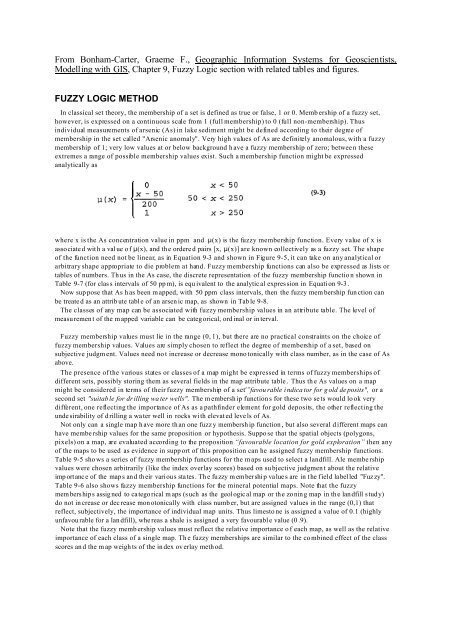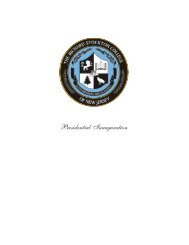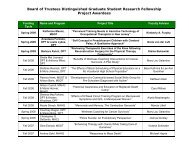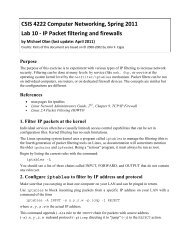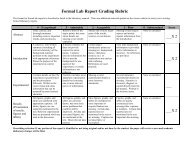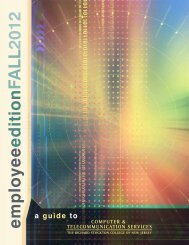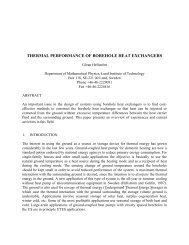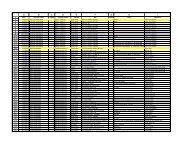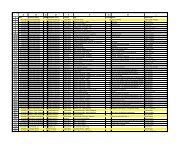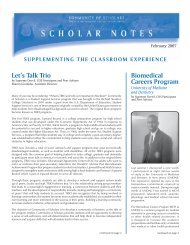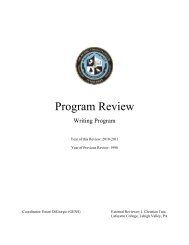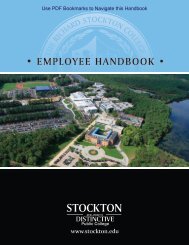Fuzzy Logic Method
Fuzzy Logic Method
Fuzzy Logic Method
You also want an ePaper? Increase the reach of your titles
YUMPU automatically turns print PDFs into web optimized ePapers that Google loves.
Table 9-6. Attribute tables for mineral potential study, showing scores for class weighting and fuzzy membershipvalues. Only 4 out of the 1 0 tables used in the study are shown. Tables have been assigned the same names astheir associated maps.A. Geolo gy (GEO L)Class Score <strong>Fuzzy</strong> Legend0 -1 0.0 ‘outside’1 9 0.8 ‘Goldenville’2 7 0.7 ‘Halifax’3 -1 0.1 ‘Granite’B. Lake Sediment Antimony (LSSB)0 1 0.1 ‘no data’1 8 0.8 ‘0.9-1.3 ppm’2 7 0.8 ‘0.8-0.9'3 6 0.6 ‘0.6-0.8'4 5 0.4 ‘0.5-0.6'5 4 0.3 ‘0.4-0.5'6 2 0.2 ‘0.3-0.4'7 2 0.2 ‘0.2-0.3'8 1 0.1 ‘
FIG. 9-5. A graph showing fuzzy membership of the set of obse rvations for whic h "arseniclevels are anomalous". <strong>Fuzzy</strong> membership can, in some cases, he expressed as an analyticalfunction, not necessarily linear as shown he re, in other cases membership is defined mo rereadily as a table.Table 9-7. <strong>Fuzzy</strong> membership function for As expressed as the ordered pairs [x, : (x)l, and organizedin a table.x:(x)300 1250 1200 0.75150 0.5100 0.2550 00 0Table 9-8. Attribute table for a map of As, with the fuzzy membership values shown as one field.MapClass<strong>Fuzzy</strong>MembershipLegendEntry1 1.00 ‘>275 ppmAs’2 1.00 ‘225 - 275'3 0.75 ‘175 - 225'4 0.50 ‘125 - 175'5 0.25 ‘75 - 125'6 0.00 ‘25 - 75'7 0.00 ‘< 25'
Table 9-5. Attribute tables for the 10 maps used for landfill site selection.A. Overburden thickness (OVERTHIK)Class <strong>Fuzzy</strong> Legend1 0.1 “1 m”2 0.3 “2 m”3 0.9 “3 m”4 0.9 “4 m”5 0.9 “5 m”6 0.9 “6 m”C. Surface slope (SLOPE)1 0.9 “low”2 0.93 0.74 0.5 “medium”5 0.36 0.17 0.18 0.1 “steep”G. 100-year flood zone (FLOOD)1 0.1 “100 yr”2 0.9 “> 100"H. Suitability for farming (SUITAB)1 0.1 “good”2 0.4 “fair”3 0.9 “poor”I. Distance from major road (ROADBUF)1 0.6 “
Combining <strong>Fuzzy</strong> Membership FunctionsGiven two or more maps with fuzzy membership functions for the same set, a variety of operators can beemployed to combine the membership values together. The book by Zimmermann (1985), for example,discusses a variety of combination rules. An et al. (1991) discuss five operators that were found to be useful forcombining exploration datasets, namely the fuzzy AND, fuzzy OR, fuzzy algebraic product, fuzzy algebraic sumand fuzzy gamma operator. T hese operators are briefly reviewed here.<strong>Fuzzy</strong> ANDThis is equivalent to a Boolean AND (logical intersection) operation on classical set values of (1,0). It is definedaswhere : A is the membership valu e for map A at a particular location, : B , is the value for map B, and so on. Ofcourse, the fuzzy memberships must all be with respect to the same proposition. Suppose that at some locationthe membership value for map A is 0.75 and for map B is 0.5, then the membership for the combination usingfuzzy AND is 0.5. It can readily be seen that the effect of this rule is to make the output map be controlled bythe smallest fuzzy membership value occurring at each location. Like the Boolean AND, fuzzy AND results in aconservative estimate of set membership, with a tendency to prod uce small values. The AND operation isappropriate where two or more pieces of evidence for a hypothesis must be present together for the hypothesis tobe true.<strong>Fuzzy</strong> OROn the other hand, the fuzzy OR is the like the Boolean OR (logical union) in that the output membership valuesare controlled by the maximum values of any of the input maps, for any particular location. The fuzzy OR isdefined as(9-4)(9-5)Using this operator, the combined membership value at a location (=suitability for landfill etc) is limited only bythe most suitable of the evidence maps. This is not a particularly desirable operator for the landfill case, butmight in some circumstances be reasonable for mineral potential mapping, where favourable indicators ofmineraliz ation are rare and the p resen ce of any po sitive evid ence may b e sufficien t to su ggest favou rability.Note that in using either the fuzzy AND or fuzzy OR, a fuzzy membership of a single piece of evidence controlsthe output value. On the other hand, the following operators combine the effects of two or more pieces ofeviden ce in a "blended" result, so th at each data source has som e effect on the output.
<strong>Fuzzy</strong> Algebraic ProductHere, the combined membership function is defined as(9-6)where : i is the fuzzy membership function for the i-th map, and i=1,2,... n maps are to be combined. Thecombined fuzzy membership values tend to be very small with this operator, due to the effect of multiplyingseveral numbers less than 1. The output is always smaller than, or equal to, the smallest contributingmembership value, and is therefore "decreasive". For example, the algebraic product of (0.75, 0.5) is 0.375.Nevertheless, all the contributing membership values have an effect on the result, unlike the fuzzy AND, orfuzzy OR operato rs.<strong>Fuzzy</strong> Algebraic SumThis operator is complementary to the fuzzy algebraic product, being defined as(9-7)The resu lt is always larger (or equal to) the largest contributing fuzzy membership value. Th e effect is therefore"increasive". Two pieces of evidence that both favour a hypothesis reinforce one another and the combinedevidence is more supportive than either piece of evidence taken individu ally. For example, the fuzzy algebraicsum of (0.75, 0.5) is 1-(1-0.75 )*(1-0.5), which equals 0.875. The in creasive effect of combining severalfavourable pieces of evidence is automatically limited by the maximum value of 1.0, which can never beexceeded. Note that whereas the fuzzy algebraic product is an algebraic product, the fuzzy algebraic sum is notan algebraic summation .Gamma OperationThis is d efine d in terms of th e fuzz y algeb raic p rodu ct and the fuzzy algeb raic su m by = (<strong>Fuzzy</strong> algebra i c sum)(9-8)where (is a parameter chosen in the range (0, 1), Zimmermann and Zysno (1980). When ( is 1, the combinationis the same as the fuzzy algebraic sum; and when ( is 0, the combination equals the fuzzy algebraic product.Judicio us ch oice of ( produces output values that ensure a flexible compromise between the "increasive"tendencies of the fuzzy algebraic sum and the "decreasive" effects of the fuzzy algebraic product. For example,if (= 0.7, then the combination of (0.75, 0.5) is 0.875 0.7 *0.375 0.3 = 0.679, a result that lies between 0.75 and 0.5.On th e oth er han d, if (=0.9 5, then th e combinatio n is 0 .839 , a mildly in creas ive re sult. If (=0. 1, then thecombin ation is 0.408, a result that is less th an the average of the 2 input function valu es, and is thereforedecreasive. T he effect of choosin g different value s of ( are shown in Figure 9-6. Note that although the sametend encies o ccur, the actual valu es of ( for which the combined membership function becomes increasive ordecreasive vary with the inpu t mem bership value s. An e t al. (1991 ) used a value o f (=0.975 to combinegeophysical and geological datasets in their study of iron and base metal deposits in M anitoba, presumablybecause th e increasive effects of larger values best seem ed to reflect the subjective decision-making of typicalexploration geologists.
FIG. 9-6. A graph of fuzzy membership, : c, obtained by combining two fuzzy memberships, : Aand : B, versus (. This showsthe effect of variations in ( for the case of combining two values, : A=0.75 and : B=0.5. When, (=-0, the com bination equalsthe fuzzy alge braic produc t; when (=l, the combination equals the fuzzy algebraic sum.. When 0.8 < (< 1, the combinationis larger than the large st input mem bership value (in this cas e 0.75), a nd the effect is therefore "increasive". When 0
Notice that for each of the 10 input maps, the 'FUZZY' column is the field in the corresponding map attributetable where the fuzzy membership functions are stored, see Table 9-5.The output map, after classification with a table of breakpoints called 'FUZTAB', show areas ranked accordingthe combined fuzzy membership, see Figure 9-2D.The procedure for the mineral potential case is similar, except for two features. First, the value of gamma isspecified as keyboard input allowing different values to be selected at run time. Second, the four lake sedimentmaps are combined using fuzzy OR, and the two biogeochemical maps are also combined with fuzzy OR. Thismeans the combined effect of the lake sediment geochemical evidence, will take on the maximum fuzzymembership of the four contributing maps. An anomalous value from any one of the maps is therefore sufficientto give this factor a large fuzzy score. The effect is the same for the biogeochemical combination. Finally, thegamma operator is used, as before, for the final combination step. The resulting map is shown in Figure 9-4D.Superficially it looks similar to the ind ex overlay, but careful comp arison sh ows some important difference s.‘Pseudocode for fuzzy combination for mineral potential‘This procedure is sh own graphically as an inference net in Figure 9 -7‘Set gamma valuegamma = 0.95‘At current location, get fuzzy membership values for each mapm1 = GEOLm2 = LSASm3 = LSAUm4 = LSSBm5 = LS0Wm6 = BIOASm7 = BIOAUm8 = ANTIm9 = GOLDHALm10 = NWLINS‘Apply fuzzy OR to lake sediment maps‘Favourable lake sed geochem is an intermediate hypothesisfavls = MAX(m2,m3,m4,m5)‘Favourable biogechem is an intermediate hypothesisfavbio = MIN(m6,m7)‘Calculate fuzzy product, sum and gamma‘Favourable location for gold deposits is a final hypothesisfprod = m1 * favls * favbio * m8 * m9 * m10fsum = 1 - (( 1 - m1 ) * (1 - favls) *(1 - favbio)*(1 - m8) * (1 - m9)*(1 - m10))favloc = fsum ^ gamm a * fprod ^ (1 - gamma)Comments on the <strong>Fuzzy</strong> <strong>Logic</strong> <strong>Method</strong>In practice, it may be desirable to use a variety of different fuzzy operators in the same problem, as shown forthe mineral potential example. In particular, fuzzy AND and fuzzy OR can be more appropriate than fuzzygamma in some situation s, but not in others. For exam ple, suppo se that two input maps represent evidence for aproposition that requires that the evidence occur jointly. To take a slightly contrived example, consider a map ofsulphur conten t and a map of zinc conten t from lithological samples. The co mbination is highly suggestiveevidence for the presence of zinc sulphide (sphalerite), an important mineral in many zinc deposits. Ignoring theobvious problems of concentration units and other factors for the sake of simplicity, we can deduce that becausethe joint presence of the two elements is needed, the importance of the evidence is limited by the lesserabundance of the two elements. In this case, fuzzy AND would be an appropriate combination operator, becauseat each location the combination would be controlled by the minimum of the fuzzy membership values. In othersituations, fuzzy OR is more appropriate, where for example, the presence of any one of the pathfinder elementsin abundance might he significant evidence for the presence of a mineral deposit, even though other pathfinderelements are no t presen t in anomalous amounts.
Evidence maps can be combined together in a series of steps, as depicted in an inference network, Figure 9-7.Thus in stead of combining all the maps in one operatio n, for example with the gamm a operator, it may be moreappropriate to link together some maps with, say the fuzzy OR to support an intermediate hypothesis, other mapswith fuzzy AND to support another intermediate hypothesis, and finally to link both raw evidence andintermediate hypotheses (now in turn being used as evidence) with a fuzzy gamma operation. Many combinationsare possible. The inference network becomes an important means of simulating the logical thought processes ofan expert. In expert system terminology, the fuzzy membership functions are the "knowledge base" and theinference network and fuzzy com bination rules are the "inference engine". <strong>Fuzzy</strong> logic is one of the tools used inexpert systems where the uncertainty of evidence is important. Even quite complex inference networks can beimplemented in a map modelling language. <strong>Fuzzy</strong> logic has also been applied to problems of pattern recognitionin geology, see Griffiths (198 7).Landfill site selection output map: Suitability usingfuzzy logic. The output is ranked according tomembership of a fuzzy set, the set comprising areasthat satisfy the proposition “This location is suitab lefor a landfill”. The degree with which the propositionis satisfied is scored on a scale from 0 to 1, thenclassified to make a map.Output maps showing gold potential: Areas rankedaccording to fuzzy membership values. The fuzzy setcomprises those locations that satisfy the proposition“favourable for gold exploration”, and fuzzymembership ranges from 0 to 1. Most of the mainknown gold o ccurrences are predicted by the model,and several new prospective areas are suggested.Fig. 9-2DFig. 9-4D


